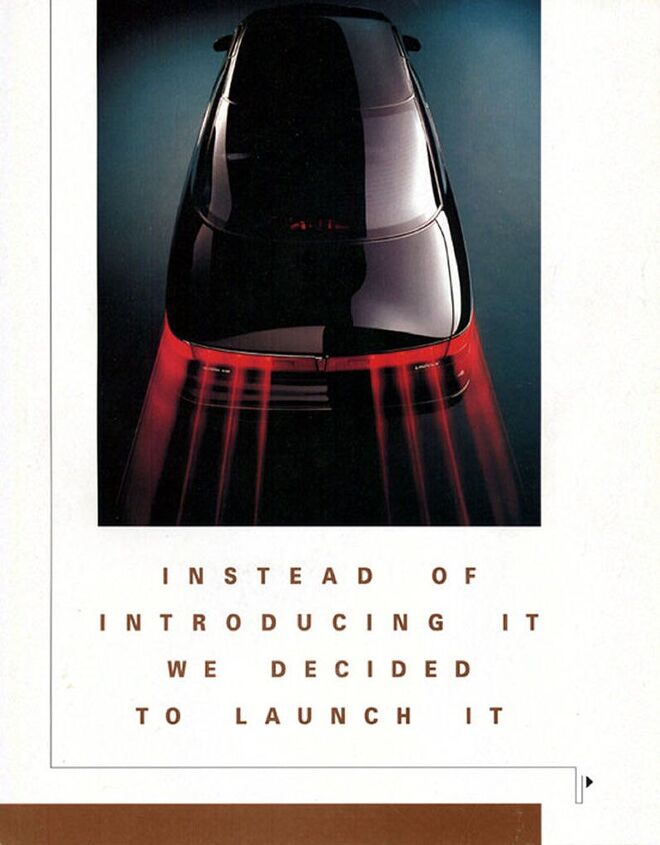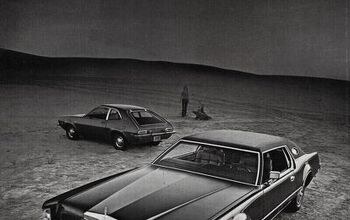Rare Rides Icons: The Lincoln Mark Series Cars, Feeling Continental (Part XLIV)

When the MN12 platform project was launched in 1984, Ford’s plan to take on European two-doors saw the standard Thunderbird and Cougar chassis lightly revised (via more aluminum) into the FN10. The FN10 was used exclusively in the Lincoln Mark VIII and also debuted an all-new sophisticated aluminum V8 engine. Unlike the Thunderbird and Cougar which shared body panels, the Mark VIII was deemed worthy of its own styling. The development of said styling was a long and bumpy road and led to a considerable delay in the Mark VIII’s launch.
Though it would ride on a new platform, the original styling directive for the FN10 project was one of evolutionary change. Automotive design was in the transition to a new era circa 1986, when exterior design work on the Mark started. Ford released the new aerodynamic Taurus that year, and across the board, the traditional box shape of the passenger car morphed into something much more modern.
Initial styling work from ‘86 was thrown into turmoil in the fall of 1988. Ford management saw upcoming designs from the competition and realized an evolutionary boxy Mark VIII wouldn’t cut it. The new ask was a complete redesign and a different styling direction to any other Lincoln, with an eye toward recognizable cues from past Marks.
Ford designer Kyu Kim was tasked with the Mark’s redesign, and his resulting vision was the “Stretch I.” With scalloped side detailing, a full-width headlamp, and an unusual upward-sloping tail lamp design, Stretch I also featured a Continental tire hump. Slim C-pillars made for a delicate appearance. No chrome was found on the design at all.
The artwork was promising enough to warrant a full-scale clay model. The new design mockup was not ready for Lincoln’s brass until December 12th, 1988. By then it was already too late for the Mark VIII to debut on time in 1990. Executives took one look at the design (no published photographs exist) and were most distressed by what they saw.
Immediate changes were ordered to Stretch I, which evolved into the Stretch II. Styling alterations included toning down the front and rear clip designs, and the addition of chrome trim expected by domestic consumers of luxury cars. Stretch II was fairly close to the Mark VIII’s production design, though more fine-tuning continued through half of 1989. The debut timeline pushed further into the future.
During that interim, Lincoln debuted a concept car at the Chicago Auto Show of 1989. Finished in monochromatic white and very aerodynamic shapes, the futuristic concept used a full-width light bar front and rear, a very thin C-pillar, and scalloped sides. Perhaps what was displayed was a version of the Stretch I? Dubbed the Machete, the two-door design reflected many of the cues that made their way into the production Mark VIII.
The Machete had a futuristic interior full of LCD screens, and a full-length console that flowed down from the dash. Only the steering wheel looked ready for production. But that was largely irrelevant, as the Machete debuted simply as a design exercise. Shown only for a short while in 1988, it disappeared thereafter.
The FN10’s styling alterations were finalized by late 1989, and road testing could begin. Prototypes with a Mark chassis that wore edited Thunderbird and Cougar bodies started on-road testing in 1990. The test mules advanced to full Mark VIII prototype bodies early in 1991. However, more time was needed and the launch was delayed again.
Around that time, Lincoln again debuted a concept car that would not reach production, and as before it appeared at the Chicago Auto Show. This time the company displayed the Marque X, a two-door convertible that wore a sleek aerodynamic shape, rear-leaning waterfall grille, and full-width headlamps. With a Continental hump at the back and a wrap-around tail lamp treatment, the Marque was a decent (if fanciful) preview of the production version of the Mark VIII.
Marque X was used as a technological display with features like fiber-optic headlamps, LEDs at the rear, navigation, a fax machine, and a key card for the ignition. Rear passengers were entertained by little TV screens too small to be useful. Notably, the steering wheel and dash design seem to match the production Mark VIII. Like the Machete, it would seem the Marque X concept was a disguised peek at part of the Mark’s development.
And perhaps it served as a nice distracting shiny object to show the media. In February 1991 shortly after on-road prototype testing began, it became clear the Mark needed more time in development. Production was scheduled to start in April 1992, and Lincoln would launch the Mark VIII in June 1992 as a ‘93 model. The timeline was moved back by a full six months.
The press launch of the Mark VIII took place in March 1992, but the public debut of the 1993 car was made at the last possible minute on November 18, 1992. Suitably, the Mark VIII debuted at the 5-star Hotel Mark in Manhattan. It seemed the extended timeline was worth it, as the Mark VIII arrived with unexpected and forward-looking styling that diverged from its predecessors. We’ll take a dive into the production looks in our next installment.
[Images: Ford, www.chicagoautoshow.com]
Become a TTAC insider. Get the latest news, features, TTAC takes, and everything else that gets to the truth about cars first by subscribing to our newsletter.

Interested in lots of cars and their various historical contexts. Started writing articles for TTAC in late 2016, when my first posts were QOTDs. From there I started a few new series like Rare Rides, Buy/Drive/Burn, Abandoned History, and most recently Rare Rides Icons. Operating from a home base in Cincinnati, Ohio, a relative auto journalist dead zone. Many of my articles are prompted by something I'll see on social media that sparks my interest and causes me to research. Finding articles and information from the early days of the internet and beyond that covers the little details lost to time: trim packages, color and wheel choices, interior fabrics. Beyond those, I'm fascinated by automotive industry experiments, both failures and successes. Lately I've taken an interest in AI, and generating "what if" type images for car models long dead. Reincarnating a modern Toyota Paseo, Lincoln Mark IX, or Isuzu Trooper through a text prompt is fun. Fun to post them on Twitter too, and watch people overreact. To that end, the social media I use most is Twitter, @CoreyLewis86. I also contribute pieces for Forbes Wheels and Forbes Home.
More by Corey Lewis
Latest Car Reviews
Read moreLatest Product Reviews
Read moreRecent Comments
- EBFlex Insatiable demand for EVs yet this happens. And a lot more layoffs at Tesla.
- SCE to AUX Maybe some Apple tech would be helpful, but please no self-driving stuff.
- SCE to AUX It's over, and over the last decade or so Henrik Fisker has left two eras of foolish customers driving paper weights.
- Kwik_Shift_Pro4X Always a good sign. 🤕 I would like to see their pitch on Shark's Tank/Dragon's Den
- Buickman I was called crazy after predicting the sale of GMAC.#canthurtme







































Comments
Join the conversation
Third picture:
Holy rear overhang, Batman!
I bought a 1998 Mark VIII from Copart in Virginia for $350. It now has just under 68,000 and runs like new. Yesterday I took delivery of a 1997 Mercury Cougar XR7 30TH Anniversary model to park next to the Mark VIII!